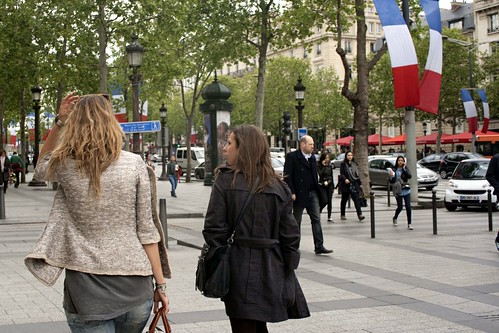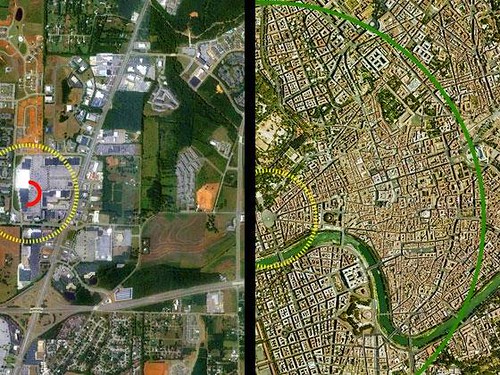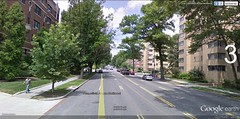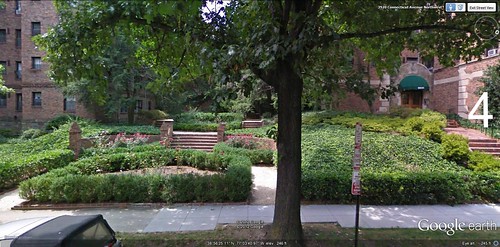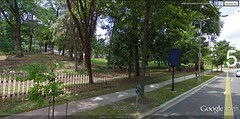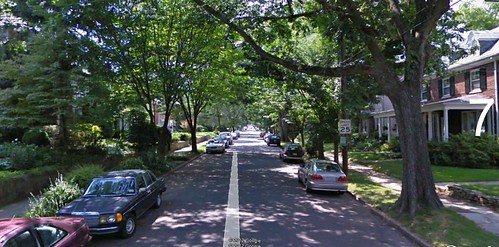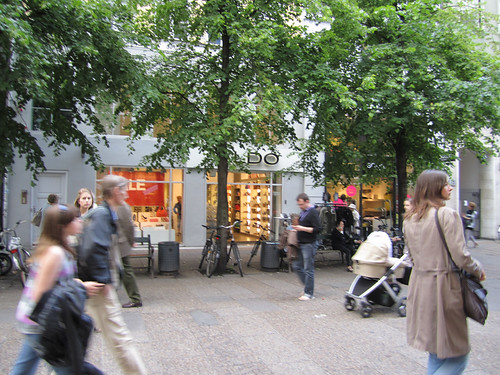How far will we walk to go somewhere? It depends.

Posted July 30, 2012 at 1:25PM
We have a number of formal and informal ways to think about what makes a good walkable community. I’ve written before about the popsicle test (can a child comfortably walk to buy a popsicle and walk back home?), the Halloween test (does the neighborhood attract kids walking door-to-door on Halloween?), and the 20-minute neighborhood (can you meet most of your daily needs within a 20-minute walk or transit ride?). My friend Steve Mouzon adds the tourist test (is a town or place good enough that people will want to vacation there?); Scott Doyon, not entirely in jest, likes the “pub shed” (how many drinking establishments are within walking distance?). For those who like numbers, the increasingly sophisticated Walk Score calculates the number and types of typical destinations within comfortable walking distance of any given location and assigns a rating based on the outcome.
Steve has now added another, very interesting idea to the mix: he posits that, in fact, “comfortable walking distance” is not a constant but a variable, and that the distances we are willing to travel on foot to do something depend on the quality of the environment along the way. Steve calls his concept “walk appeal.” Streets and neighborhoods that entice us to walk farther have greater walk appeal.
In Steve’s provocative blog Original Green, he illustrates the idea by comparing two different environments that produce very different outcomes as to how far one is likely to walk:
“Walk Appeal . . . explains several things that were heretofore either contradictory or mysterious. It begins with the assertion that the quarter-mile radius (or 5-minute walk), which has been held up for a century as the distance Americans will walk before driving, is actually a myth.
“Both images below are at the same scale, and the yellow dashed line is a quarter-mile radius. On the left is a power center. As we all know, if you're at Best Buy and need to pick something up at Old Navy, there's no way you're walking from one store to another. Instead, you get in your car and drive as close as possible to the Old Navy front door. You'll even wait for a parking space to open up instead of driving to an open space just a few spaces away . . . not because you're lazy, but because it's such a terrible walking experience.
“The image on the right is Rome. The circles are centered on the Piazza del Popolo (North is to the left) and the Green radius goes through the Vittorio Emanuele on the right. People regularly walk that far and then keep on walking without ever thinking of driving.”
As you can see, the distance that Steve suggests one will happily walk in the depicted section of Rome is far, far longer than the distance between the two stores in the American power center. And I don’t doubt for a minute that Rome has a great deal more appeal to walkers than your typical parking lots fronting a couple of big-box stores.
Continuing, Steve suggests that one will walk two miles or farther in a world-class city such as London or Paris, but “put a Parisian accustomed to walking five miles or more per day on a suburban American cul-de-sac, and they wouldn't walk much.” He further posits that people will walk about three-quarters of a mile on a good American Main Street, where buildings tend to have entrances right along the sidewalk and narrow storefronts to provide variety in the walker’s view. For residential areas, Steve says that, if a neighborhood is or mimics a traditional (pre-1950) one, we typically will walk about a quarter of a mile. But in sprawling suburbs, the distance drops to about 250 feet, and in a power center of big-box stores the distance drops to 100 feet.
In his post, he elaborates:
“People won't walk across a sea of parking to get to another store because the walking experience is simply too dreadful. This is exacerbated by the fact that a sea of parking is a heat island, capturing and storing the sun's heat in all that dark asphalt, raising the temperature of the air above it by dozens of degrees in summertime. A sea of parking is also a huge stormwater runoff problem, and is most often solved by building really ugly stormwater retention pits nearby. If you don't know what they are, a retention pit is a depression several feet deep in the ground, usually surrounded by an ugly chain-link fence, where all the styrofoam cups, packing peanuts, and plastic wrapping collects after a rain.”
So, one could say that a street in the heart of a world-class city has much more walk appeal than a typical suburban American street, and that a traditional Main Street has more walk appeal than big-box stores separated by a large parking lot. Steve says that “Walk Appeal promises to be a major new tool for understanding and building walkable places.”
Intuitively, I think he is on to something here. But it raises a lot of interesting questions that I think also deserve to be in the conversation. The most obvious, I suppose, is whether empirical research is consistent with the theory. I suspect it is, at least directionally, but one would like to base “a major new tool” on solid, proven facts.
In addition, as I’m sure Steve would agree, there are all sorts of variables and additional factors to consider:
- Purpose. To an extent, I think Steve’s examples compare apples, oranges, pears, and grapes. We travel in different places for different reasons that affect our willingness to walk. In particular, to make the power-center-versus-Rome comparison a fair one, a hypothetical traveler would have to be on the same sort of journey. In the original example, the traveler started at Best Buy, an electronics store. If she were there to purchase, say, a television, then the chances that she will be walking two miles to her next shopping destination are slim even if she has the option of walking down Rome’s finest street to get there. One typically goes to Best Buy and Old Navy for different purposes than one walks two miles in Rome. (Incidentally, I recall buying a bunch of heavy wool sweaters in Dublin and walking two miles along very pleasant streets to my next destination, the finish of a bike race. The second mile was no fun, and next time I’m taking a taxi.)
- Safety. A long walk that is visually appealing but in a sketchy area for crime is unlikely to have much walk appeal, even if its urbanism suggests that it should. Also, does walk appeal vary by time of day? I suspect it does; I’ll walk farther in daylight than in the dark, unless it’s oppressively hot in the daytime.
- Convenience and time. Just speaking for myself, I will indeed walk two miles in parts of New York or Paris or Washington if I can spare the time, but depending on terrain, climate, crosswalk interruptions and other factors it will probably take me somewhere between 30 and 45 minutes. When I leave my office for home via the DC Metro, for example, I frequently get off a stop or two early, so that I can enjoy a longer, pleasant walk home – one to one and a half miles instead of just the half mile from the stop nearest my house. But not if I’m short of time. (Of course, my experience in New York is that it is going to take me a long time to get anywhere no matter which mode I choose, so I might as well walk even if the route isn’t that pleasant.)
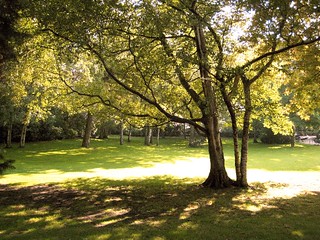 Nature. It’s not just about streets and buildings. I will walk farther if I can traverse or at least walk alongside a park on the way to my destination. In fact, I will deliberately lengthen my journey in order to go through a great park such as the Jardin du Luxembourg in Paris. So will many people I know. We humans are biophilic creatures.
Nature. It’s not just about streets and buildings. I will walk farther if I can traverse or at least walk alongside a park on the way to my destination. In fact, I will deliberately lengthen my journey in order to go through a great park such as the Jardin du Luxembourg in Paris. So will many people I know. We humans are biophilic creatures.- Alternatives. Just as there are places where walking is a terrible experience, there are places where driving is a terrible experience. Heck, there are places where public transportation is a terrible experience, too. (Arguably, most American cities fall into the latter category.) We weigh the costs and benefits of our choices and may walk farther if the other options are poor.
- Environmental intensity. In one of Steve's blog posts, a commenter suggested that "people density," creating a sense of liveliness, is helpful. I would agree, but to a point. Crowds can be oppressive and can slow one's walk. Sound matters, too: music can be helpful, but construction noise is a killer for walking. Construction sites in general can severely limit the appeal of walking. So can the kinds of streets I frequently encounter in New York where trucks are constantly loading and unloading things and businesses leave their garbage in the street for pickup. I suppose the trick is to be in the range where there is enough intensity to add interest but not so much as to make the walk unpleasant.
In the first of what Steve promises will be a series of follow-up posts, he takes the idea a bit further and suggests that walk appeal can be measured, or at least that some of its key ingredients can be. Here are some of the factors he highlights:
- Visual variety. “The more frequently you change someone's view as they walk, the better you entertain them.”
- Street enclosure. “The best streets on earth have building walls on either side that are as tall as the space between the building faces.” I think I generally agree with this, but perhaps not to the extent of numerical precision that many of my architect and planner friends do. In addition, I think one can have too much enclosure, blocking daylight and creating a closed-in feeling. I also like it when building heights have a bit of variety.
- Windows. Windows along the street are better than blank walls. Agreed, though again I think people sometimes get a bit too numerical about it (“The ideal percentage of glass at eye level along the sidewalk is around 70%.” “The maximum sill height should be 30 inches”).
 Shelter. “The best building fronts shelter people who are walking from the elements, at least at the front door.” I would agree much, but perhaps not all, of the time. I’m a fan of porches, awnings and such, but in the DC area there are many exceptionally appealing historic streets in Georgetown, Alexandria and Annapolis that make for an argument to the contrary.
Shelter. “The best building fronts shelter people who are walking from the elements, at least at the front door.” I would agree much, but perhaps not all, of the time. I’m a fan of porches, awnings and such, but in the DC area there are many exceptionally appealing historic streets in Georgetown, Alexandria and Annapolis that make for an argument to the contrary.- “Goals in the middle distance.” If there are landmarks along the way – a steeple or monument, perhaps – we can more easily sense progress and enjoy the walk more.
- Appealing corners. When we turn from one street to another, we may find ourselves along the side of a building instead of its front. Boring sides diminish the walk appeal.
I prefer to think of Steve’s list as suggestions for architects and planners – a basket of techniques that a designer can draw from when designing streets and buildings, particularly areas with significant commercial presence -- more than “measurables,” as he calls them. (Steve is himself an architect and designer, so it makes sense that his emphasis is on design.) But I think this business of what makes places appealing to walkers may be as much art as science.
For example, I grabbed a bunch of images from Google Earth in order to show parts of my walk home from Metro when I choose one of the longer-than-necessary options (in this case, 1.16 miles instead of 0.58 miles from the nearest stop). The route has immense walk appeal for me – I take it by choice – yet it would be found lacking on some (not all) of the components that Steve mentions, and it has significant walk appeal assets on some components that he does not mention, such as the presence of nature and pleasant residential architecture. I bring this up not to challenge my friend but just to add to the discussion.
Now, to be fair there is a section between numbers 6 and 7 above that I am not showing because it's institutional and somewhat dreary, for just the sorts of reasons that Steve cites as indicating a lack of walk appeal. If the entire route were like that, I would probably walk it less frequently.
What I like best about the concept of walk appeal is the suggestion that a comfortable or pleasant walking distance is highly variable, and that part of the reason we choose to drive even short distances sometimes is that the experience of walking to them is so horrible. Steve has provided some useful new vocabulary and an interesting new frame through which we can evaluate streets and neighborhoods.
I’m all in on those ideas, and think Steve came upon a “Eureka!” moment when he found a way to articulate it. I’m going to keep reading – Steve’s writing is almost always engaging, and this time he has sparked a dialogue among his architect and planner friends, as well. But my hunch is that, for me at least, it is the idea of walk appeal that has power, and I would caution against getting too quantitative or definitive about its application.
Related posts:
- A short walk reveals the simple delights of cities worth loving (May 22, 2012)
- Is placemaking a "new environmentalism"? (April 23, 2012)
- Data summaries show walkable communities are good for our health, and for business, too (April 13, 2012)
- Madness: the NCAA Sweet Sixteen decided by Walk Score! (March 20, 2012)
- City places that inspire romance (a gallery of walkability, part 2) (February 13, 2012)
- Blog post number 1000: A gallery of walkability (January 30, 2012)
- When shops and services are within walking distance, we walk more and drive less (January 11, 2012)
- Walking is good for us. So why isn't it safer? (August 19, 2011)
Move your cursor over the images for credit information.
